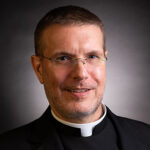DEAR FATHER | The funeral liturgy should draw the faithful into the true perspective of faith in the Risen Christ
When meeting with the priest to plan a family member’s funeral, he told us that several of the things we wanted to do ‘weren’t allowed.’ His children were very upset. Why is the Church so strict about funerals?

There are many options for planning a Catholic funeral, so I’m not sure that “strict” is the best adjective to describe the Church’s approach. According to the Catechism of the Catholic Church, “the different funeral rites express the Paschal character of Christian death and are in keeping with the situations and traditions of each region” (CCC 1685). It goes on to say that there are different types of funeral celebrations in the Roman liturgy and are determined “by the importance attached to them by the family, local customs, the culture, and popular piety” (1686).
This flexibility is based on pastoral sensitivity to the bereaved. In the case of a funeral Mass, there are multiple Scripture readings to choose from and prayers appropriate to the deceased (e.g. an adult, a child, a person who died by suicide, etc.). Because it is liturgy, there are still rubrics that need to be followed. The music should be liturgical (not secular), the homily must be given by a priest or deacon, and, while there is a certain amount of choice regarding the color of vestments, flowers and altar dressings, secular symbols are not allowed. An example of this is the use of the U.S. flag for a veteran. The flag can be draped over the casket during the viewing and after the liturgy, but during the funeral Mass itself, a pall covers the casket. While there is greater flexibility in a funeral liturgy outside of Mass (or at a graveside service), there are still basic liturgical norms to follow.
Why is this? The focus of any funeral liturgy is to pray for the deceased, to commend his or her soul to God and to proclaim the Church’s central belief that Christ has conquered death and promises eternal life to those who love Him. For that reason, the funeral homily during the Mass should avoid becoming a “eulogy” that focuses primarily (or exclusively) on the person himself, rather than on our faith in Christ and His consolation to those who mourn. For the people in attendance, not only does this offer hope and comfort, but it invites them into a deeper relationship with God following the service.
That being said, there are still many opportunities for honoring the deceased during the visitation, before and after the funeral and at the cemetery. I once had a family whose dad had been a huge Iowa Hawkeyes fan. They requested that the “Iowa Fight Song” be played as the recessional at the funeral Mass. Had I simply said, “Sorry, that’s not allowed,” they would have been understandably hurt. Rather, I suggested that they play it at the conclusion of the graveside service at the cemetery as a sort of “final sendoff.” They were happy with the idea and found it to be a fitting tribute to the man’s love for Iowa college football.
Ultimately, the funeral liturgy is, according the Catechism, “an event that should lead beyond the perspectives of ‘this world’ and should draw the faithful into the true perspective of faith in the Risen Christ” (1687). Far from being strict or indifferent to the pastoral needs of those who mourn, the intent is that they come away with a renewed sense of hope that will sustain them in the difficult days to follow.
Father Scott Jones is the episcopal vicar for the Northern Vicariate of the Archdiocese of St. Louis.



